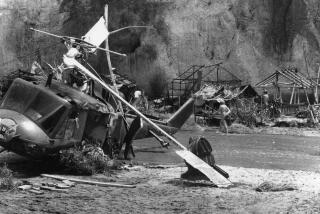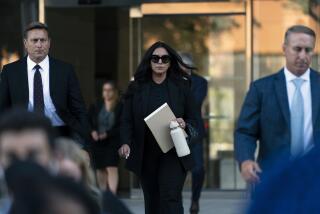Had No Fears That Scene Was Unsafe, ‘Twilight’ Pilot Testifies
- Share via
“Twilight Zone” helicopter pilot Dorcey Wingo testified Thursday that he was never worried that a filming sequence in which three actors ultimately died would prove unsafe, even though there were problems in filming the previous sequence.
Wingo, the second defendant in the involuntary manslaughter trial to take the witness stand, said he became agitated and angry over the effects of spraying water and intense heat stemming from special-effects explosions during a sequence filmed three hours before the July, 1982, tragedy. Wingo, a former Army helicopter pilot in Vietnam, said that heat from the explosives turned his cheeks pink but that he required no medical treatment.
In the time before the fatal shot, Wingo said, he warned unit production manager Dan Allingham that “surprises would not be acceptable”; asked director John Landis, “How would you like the fireball under you right now?” and told special-effects coordinator Paul Stewart, “There can be absolutely nothing, no debris in the air around the helicopter. . . . (It) is a fragile machine.”
Wingo said that Landis in turn told him that “it was up to me where we would put the helicopter (in the final scene),” and that Allingham asserted, “Don’t worry, we’re going to be clear of the set when it goes up.”
Asked by his attorney, Eugene L. Trope, whether he had received adequate assurances that the final scene was planned safely, Wingo replied with a firm “yes.”
Wingo, Landis, Allingham, Stewart and associate producer George Folsey are charged with criminal negligence in the deaths of actor Vic Morrow and two child actors, who were killed when the helicopter crashed atop them after being struck by the fireball of a special-effects explosive.
Outside the courtroom, Trope and other defense lawyers said that Wingo, by detailing a series of production meetings and safety concerns that were expressed by the defendants, did nothing to damage any of the defendants’ cases during his second day on the witness stand. Blame for the accident, they maintained again, rests with a non-defendant, special-effects man James Camomile, who set off the fatal explosives while the helicopter was overhead.
“Should he have known that Camomile was an idiot and blew something up without looking where the helicopter was?” Trope asked rhetorically. Camomile, who was granted immunity by the prosecution in exchange for his testimony, acknowledged before the jury that he indeed set off the explosives before the helicopter was safely out of the way.
Deputy Dist. Atty. Lea Purwin D’Agostino, however, has repeatedly contended throughout the seven months of the trial that whatever the case, the defendants were remiss for having placed in proximity the actors, explosives and a helicopter hovering at 24 feet.
D’Agostino, who is expected to begin cross-examining Wingo on Monday, contended outside court that the 40-year-old pilot’s testimony was fraught with contradictions when compared to his previous testimony to National Transportation Safety Board investigators shortly after the crash. The prosecutor declined to cite specifics, saying it would give away her strategy, except to note that Wingo testified to “multitudinous meetings” with Landis and other crew members that he never had disclosed in the past.
Landis, the other defendant to have taken the stand, also testified to a series of production meetings where safety concerns were addressed.
Wingo, a Rialto resident who has served as a commercial pilot everywhere from Peru to Disneyland, also testified Thursday that he had direct communication links with the ground during the filming and heard assistant director Elie Cohn say “lower, lower, lower” as the helicopter descended into the view of a camera for the final filming sequence of a mock Vietnam battle scene. The prosecution has questioned whether Wingo had adequate radio contact with the ground crew.
Wingo said that he once warned Morrow “to keep an eye on the helicopter at all times” so he could be prepared “to get out from under it” if the engine died.
More to Read
Only good movies
Get the Indie Focus newsletter, Mark Olsen's weekly guide to the world of cinema.
You may occasionally receive promotional content from the Los Angeles Times.










